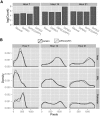A Novel Automated High-Content Analysis Workflow Capturing Cell Population Dynamics from Induced Pluripotent Stem Cell Live Imaging Data
- PMID: 27256155
- PMCID: PMC5030730
- DOI: 10.1177/1087057116652064
A Novel Automated High-Content Analysis Workflow Capturing Cell Population Dynamics from Induced Pluripotent Stem Cell Live Imaging Data
Abstract
Most image analysis pipelines rely on multiple channels per image with subcellular reference points for cell segmentation. Single-channel phase-contrast images are often problematic, especially for cells with unfavorable morphology, such as induced pluripotent stem cells (iPSCs). Live imaging poses a further challenge, because of the introduction of the dimension of time. Evaluations cannot be easily integrated with other biological data sets including analysis of endpoint images. Here, we present a workflow that incorporates a novel CellProfiler-based image analysis pipeline enabling segmentation of single-channel images with a robust R-based software solution to reduce the dimension of time to a single data point. These two packages combined allow robust segmentation of iPSCs solely on phase-contrast single-channel images and enable live imaging data to be easily integrated to endpoint data sets while retaining the dynamics of cellular responses. The described workflow facilitates characterization of the response of live-imaged iPSCs to external stimuli and definition of cell line-specific, phenotypic signatures. We present an efficient tool set for automated high-content analysis suitable for cells with challenging morphology. This approach has potentially widespread applications for human pluripotent stem cells and other cell types.
Keywords: CellProfiler; HipDynamics; high-content screening; iPSC; live imaging.
© 2016 Society for Laboratory Automation and Screening.
Conflict of interest statement
The authors declared no potential conflicts of interest with respect to the research, authorship, and/or publication of this article.
Figures




References
-
- Stephens D. J., Allan V. J. Light Microscopy Techniques for Live Cell Imaging. Science 2003, 300, 82–87. - PubMed
-
- Meijering E. Cell Segmentation: 50 Years down the Road. IEEE Signal Processing Magazine 2012, 29, 140–145.
-
- Wu Q., Merchant F. A., Castleman K. R. Microscope Image Processing; Academic Press: Burlington (MA), 2008.
MeSH terms
Grants and funding
LinkOut - more resources
Full Text Sources
Other Literature Sources

